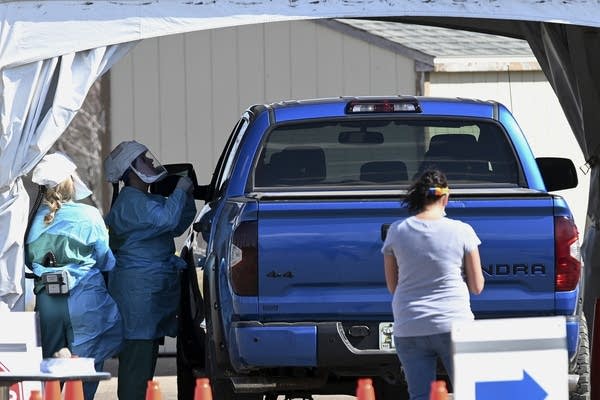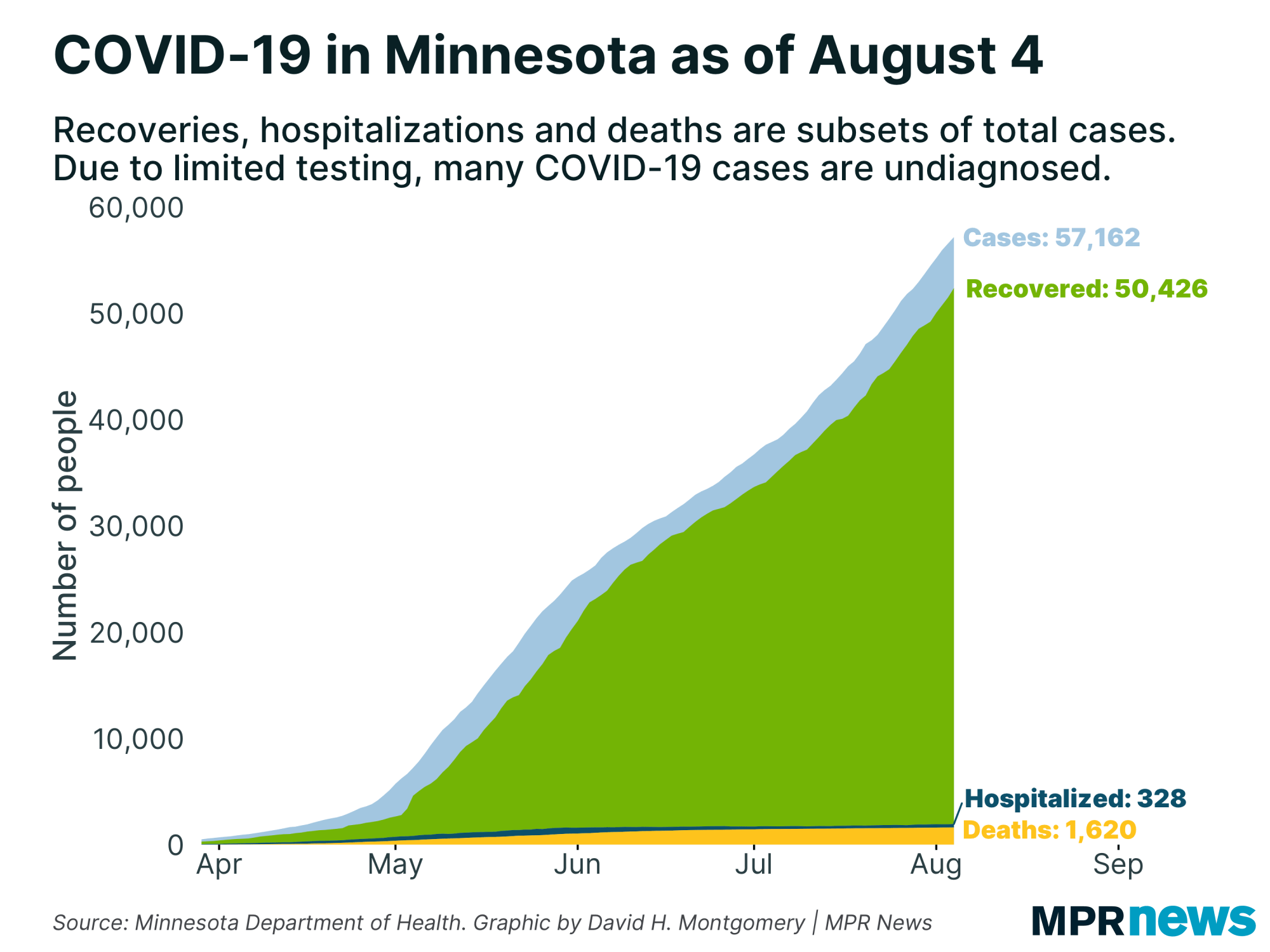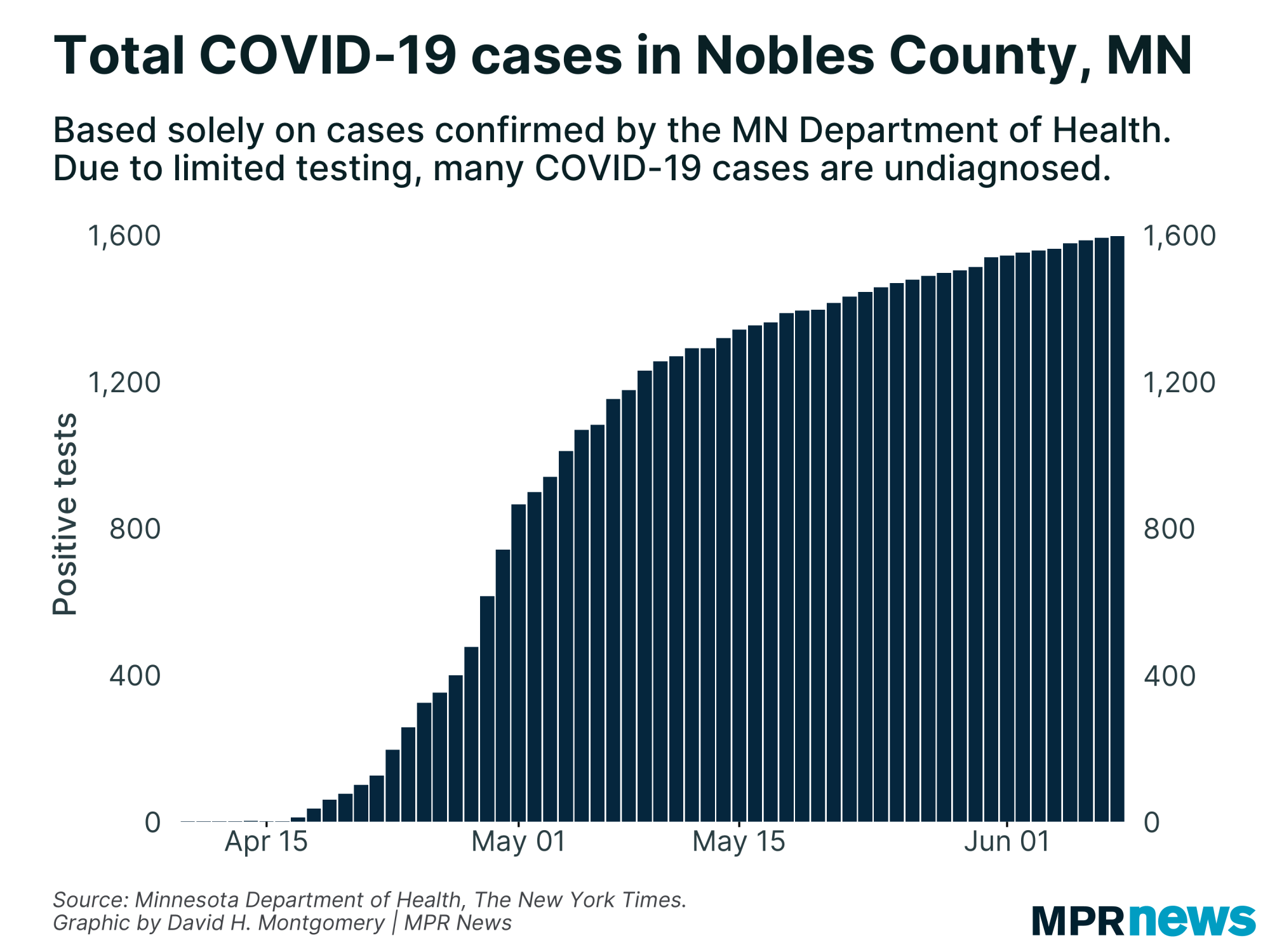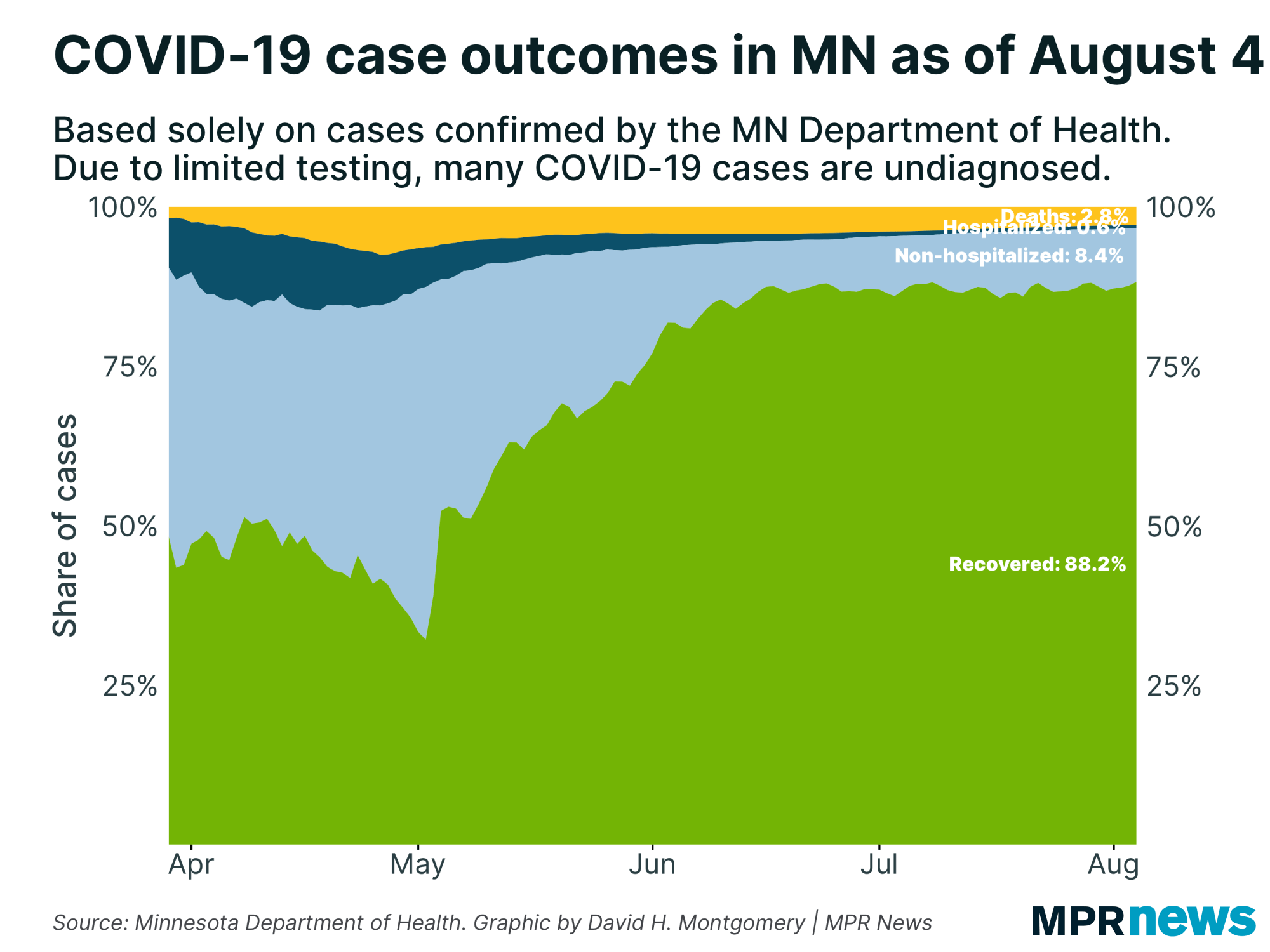May 7 update on COVID-19 in MN: Deaths top 500, on pace for 1K by June

Updated: 5:48 p.m. | Posted: 5:30 a.m.
Gov. Tim Walz and state health officials Thursday detailed a new “battle plan” to safeguard Minnesotans living in long-term care facilities from COVID-19. They also braced Minnesotans to expect more cases and deaths across the state, and noted the disease is falling harder on people of color.
Long-term, congregate care operations have concerned officials since the pandemic began, given the medical vulnerability of people living there. About 80 percent of the deaths from COVID-19 in Minnesota involve people living in long-term care. Almost all had underlying health problems.
The new focus includes expanded testing, more personal protective gear for health workers and ensuring “adequate” staffing levels when workers fall ill.
Health Commissioner Jan Malcolm called staffing a “chronic problem” even before the outbreak. Among the options under consideration: bringing in “strike teams” of health care workers furloughed from other jobs who could fill the breach at a facility in need. Walz also suggested National Guard members might be deployed.
Create a More Connected Minnesota
MPR News is your trusted resource for the news you need. With your support, MPR News brings accessible, courageous journalism and authentic conversation to everyone - free of paywalls and barriers. Your gift makes a difference.
1,000 dead by the end of May?
News of the sharper focus on long-term care facilities came hours after the Health Department reported Minnesota reached two more sad milestones.

COVID-19 deaths rose to 508 Thursday — 23 more than Wednesday — and total cases since the pandemic began crossed 9,000. The number of patients still hospitalized (435) and in intensive care (182) remained relatively stable from the prior day.
“We are still building toward the peak” of overall COVID-19 cases and hospitalizations, Malcolm said of Minnesota’s epidemic. “We are on the steep part of the curve and we’re just going to expect to see more and more cases each day. As we test more, we will find more."
Walz projected that Minnesota’s COVID-19 death toll would reach 1,000 by the end of May at the current pace. "We may be one of the last states to peak. But we're going to peak.”
African immigrant health care workers hit hard
Malcolm also acknowledged the disease is falling disproportionately on people of color in Minnesota. Case rates among black Minnesotans are twice their proportion of population as a whole and three times the hospitalizations compared to white population, she noted.
Similar worrisome trends can also be seen in the illnesses among care workers in congregate care facilities. Malcolm said the workforce in those facilities was about 74 percent white, 19 percent black and 5 percent Latino. But among those workers testing positive, 38 percent were white, 43 percent black and 6 percent Latino.
African immigrants make up a “critical part of the workforce,” Malcolm said. “We can see with this data that they are being quite disproportionately affected as well.”
Of Minnesota’s total positive tests for COVID-19, 1,205, about 13 percent, have been health care workers, the Health Department reported Thursday.
Meatpacking remains at the center of case jumps
Total confirmed COVID-19 cases hit 9,365, up 786 from Wednesday, the largest single-day jump in cases. It continues a string of days of accelerating case counts as testing for the virus intensifies.
Many of the recent outbreaks outside the Twin Cities metro area are focused around meatpacking plants. Officials have accelerated testing in those hot spots, uncovering more infections.
Southwestern Minnesota’s Nobles County, where an outbreak centered around the JBS pork plant in Worthington, continued to have the largest outbreak outside the Twin Cities and the largest by far of any Minnesota county relative to its population.
About 1 in 20 people in Nobles County have tested positive for COVID-19. In mid-April , there were just a handful of cases. On Thursday, there were 1,153 confirmed cases as testing in the region ramped up.
The JBS plant shut on April 20 and partially reopened Wednesday with expanded hygiene and health monitoring measures.

Similar problems have been reported in Stearns County, where COVID-19 cases tied to two packing plants — Pilgrim’s Pride poultry plant in Cold Spring and Jennie-O Turkey in Melrose — have skyrocketed. An undisclosed number of workers at both plants have tested positive for the virus.
There were 55 confirmed coronavirus cases in Stearns early last week. By Sunday, as testing intensified, there were 589. And by Thursday confirmed cases had jumped to 1,161, surpassing Nobles County.
Kandiyohi County in west-central Minnesota is also seeing cases jump two weeks after officials with the Jennie-O turkey processing plant there said some employees had tested positive for the coronavirus. The county had confirmed three COVID-19 cases back then. On Thursday, the Health Department reported 238 people have now tested positive.
Bit of breathing room on medical gear
Walz has argued that stay-at-home orders and other measures to keep people out of crowded public spaces bought the health care system time to secure supplies and prepare for the surge.
There was some good news Wednesday on that front: Officials say Minnesota appears to be doing better now securing the protective gear it needs for health care workers following an early, frustrating scramble for supplies at the start of the pandemic.
Officials, though, cautioned that acquiring N95 masks and gowns, gear crucial to health care worker safety, was was still a challenge and that the “burn rate” through those stockpiles will increase as Minnesota hospitalizations continue to rise toward peak.
Some businesses back to work, others frustrated
The governor has said about 91 percent of Minnesota’s workforce is now able to return to their workplaces with hygiene and distancing rules in place, under his tweaked stay-at-home order.
Restrictions have also been loosened on some retailers, allowing customers to buy online and pick up goods curbside. On Wednesday, he gave the OK to restart elective surgeries and dental services.
Still some Republicans and business owners have prodded Walz to move faster.
Earlier this week, a Twin Cities barbershop owner publicly defied Walz’s order and opened his shop to customers. Leaders in the town of Lakefield, in southwestern Minnesota, recently voted to support businesses that want to defy Walz’s order and reopen. In northwestern Minnesota, the Thief River Falls City Council asked for their city to be exempt from the order.
Walz on Thursday acknowledged the seeming unfairness that a small-town retailer would have to stay closed while a big-box store competitor nearby was allowed to stay open. He hinted that more latitude with retail business is coming down the pike.
"I think they've done a heck of a lot of work towards that," he said.

Walz says fish near home for Saturday’s opener
The governor on Thursday reiterated the Minnesota Department of Natural Resources call for anglers to stay close to home for this weekend's fishing opener. Officials are asking anglers not to stay overnight, to bring all the supplies they need, and to only travel as far as they can go and return on a single tank of gas.
The DNR has already sold more than 350,000 fishing licenses this year. The department says it doesn't anticipate issuing citations and plans to continue to use an educational approach to enforcing the stay-at-home order.
Fishing resorts are open, although many are reporting large numbers of cancellations.
Walz said while Minnesota wouldn’t be setting up roadblocks at the borders to keep out anglers from the Dakotas, Iowa and Wisconsin, but “our guidance is to stay close to home. The more people travel, the more the spread.”
He also urged people who are driving north for fishing not to stop for gas or food.
“This is not about defying an order that I put out,” he said. “This is about defying public health warnings. This is about defying the science of how this spreads.”
Developments from around the state
MN House approves measure to help low-income Minnesotans, small business owners
The Minnesota House on Thursday passed legislation to help many people with low incomes and small business owners get through the COVID-19 pandemic. The vote was 75-58.
The bill includes money for emergency housing assistance, rural broadband and small business loans. It also has temporary pay raises for the personal care assistants who care for the elderly and disabled. The $208 million measure would be partially paid for with recently received federal funds related to COVID-19.
DFL House Majority Leader Ryan Winkler, of Golden Valley, said the assistance is critical.
“Those workers, those families, those businesses are essential to our state, and Minnesota has to act to help them get through this crisis,” Winkler said. “If we do nothing, if we let them fall through the cracks and be left behind, we are going to have a much, much slower economic recovery afterward.”
House Republicans argue that with a large budget deficit ahead, the bill is not affordable. But Republican House Minority Leader Kurt Daudt, of Crown, and other Republicans argued that a better approach would be allowing businesses to reopen.
“The best thing that you can do is [to] allow these businesses to open up safe,” Daudt said.
Senate Republicans are trying to provide help through a package of tax breaks.
— Tim Pugmire | MPR News
Hennepin Co. Board chair: No property tax increase next year
The chair of the Hennepin County Board said Thursday that the county will not raise property taxes next year. County Administrator David Hough said the county will need to find $50 million in cost savings to meet that target.
The board is also planning a phased reopening of public facing services. Hough said some of the changes made during the shutdown, like online services and digital document access will continue. He said most employees will also continue to work from home with help from video conferencing programs.
"Nearly every department I have met with, so far has indicated these products have transformed their ability for staff to meet together while they are apart,” Hough said.
Hough said the county is already reducing costs through a hiring freeze and not refilling jobs that open up through attrition. The board will hear more cost saving proposals in the coming weeks.
— Brandt Williams | MPR News
Fargo leaders look to ‘test their way out’ of virus surge
Officials say they’ve identified several COVID-19 hot spots in and around Fargo, which is North Dakota’s biggest city and which has had more confirmed cases of the disease than any other community in the state.
With the rate of COVID-19 cases and deaths in the Fargo area continuing to dwarf the rest of the state, Gov. Doug Burgum is calling on local representatives to help slow the spread. He has promised resources to help with testing and other measures he believes will keep people healthy and businesses open.
Fargo Mayor Tim Mahoney, a member of the newly created Red River Valley COVID-19 Task Force, said Thursday that he believes the city and county can “test our way out of this.”
— The Associated Press
Churches, small business owners sue Walz to end stay-home order
A group of small business owners and churches are plaintiffs in a lawsuit asking the U.S. District Court for Minnesota to strike down Gov. Tim Walz's stay-at-home order.
The churches are asking that they be allowed to hold in-person services. The businesses include a chain of hair salons, a gift shop and a minigolf course in Blaine. They're arguing that Walz's orders violate the Constitution and that they deserve compensation.
Attorney Doug Seaton said the plaintiffs feel like they've been unfairly asked to close while businesses like liquor stores remain open.
"They're very upset about it, so they've lost income in the case of the businesses, and they've lost the ability to conduct services on the part of the churches,” Seaton said. “These businesses and churches can all select the CDC guidelines but they've been selected as the victims of the governor's orders even though equally positioned other businesses and organizations are carrying on their activities.”
The governor's office says he was forced to take drastic action, but that it's well within his authority and similar to what other states are doing to protect citizens. State Attorney General Keith Ellison said in a statement Wednesday that his office hasn’t seen the lawsuit, but “I don’t need to see the specifics of the lawsuit to know that it’s a distraction from what we all need to be focused on — fighting the pandemic.”
“Let’s be clear that they’re choosing to play politics rather than focus on keeping people safe,” Ellison said.
— Jon Collins | MPR News
Top headlines
Call to investigate poultry plant as Stearns County COVID-19 cases rise: In the past two weeks, Stearns County has emerged as a hot spot of COVID-19, with confirmed cases topping 1,100 on Thursday, as workers at a poultry processing plant in the county say their company hasn’t done enough to protect their health.
Legislature agrees on measures to make voting safer: The Minnesota Senate passed a bill Thursday that unlocks $17 million in federal funding that will be used to protect polling places from the spread of the coronavirus.
Store workers are now likely masked; customers, less so: Although most major retailers are requiring employees to wear masks while working, some stop short of requiring customers to also wear masks while shopping.
Deficit leaves lawmakers with painful math problem: Now that Minnesota lawmakers have a better idea of the budget problem they're facing, some want to take decisive action quickly to start closing the $2.4 billion projected deficit. But they also don’t know how federal assistance will shake out or how long the pandemic — and the economic fallout — will last.
Conservation officers prepare for Saturday's fishing opener: Minnesota Conservation officers expect a busy walleye fishing opener, doing their jobs while considering the risk of COVID-19.
Pandemic brings fewer drivers, more speeding to Minnesota highways: The rush in speeding shows up in multiple ways in an MPR News analysis of speeding tickets issued by the Minnesota State Patrol, which enforces traffic laws on Minnesota highways.
COVID-19 in Minnesota
Health officials for weeks have been increasingly raising the alarm over the spread of the novel coronavirus in the United States. The disease is transmitted through respiratory droplets, coughs and sneezes, similar to the way the flu can spread.
Government and medical leaders are urging people to wash their hands frequently and well, refrain from touching their faces, cover their coughs, disinfect surfaces and avoid large crowds, all in an effort to curb the virus’ rapid spread.
The state of Minnesota has temporarily closed schools, while administrators work to determine next steps, and is requiring a temporary closure of all in-person dining at restaurants, bars and coffee shops, as well as theaters, gyms, yoga studios and other spaces in which people congregate in close proximity.